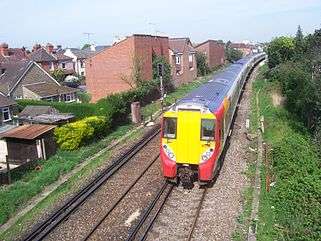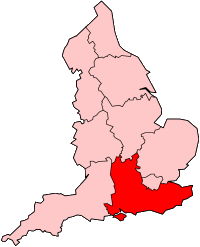Waterloo to Reading Line
| Waterloo to Reading Line | |
|---|---|
 | |
| Overview | |
| Type | |
| System | National Rail |
| Status | Operational |
| Locale | |
| Termini |
London Waterloo Reading |
| Stations | 26 |
| Operation | |
| Owner | Network Rail |
| Operator(s) | South West Trains |
| Depot(s) | Clapham Junction |
| Rolling stock | |
| Technical | |
| Track gauge | 1,435 mm (4 ft 8 1⁄2 in) standard gauge |
| Electrification | 750 V DC third rail |
The Waterloo to Reading Line is a National Rail mainly suburban electric railway line between London Waterloo station and Reading railway station, running westwards from Central London to Reading, in central Berkshire. Its passenger operation is by South West Trains (SWT) which also manage its stations.
The Waterloo to Reading line is the core of a group of lines and branches heading generally westwards from Waterloo, providing predominantly passenger services into London. All of the branches and connecting lines have direct services into a dedicated group of platforms at Waterloo, so most of the services using the line do not run the whole length of the line. After leaving Waterloo, the line runs parallel to the South West Main Line before diverging at Clapham Junction and heading westwards. Within Greater London, the Hounslow Loop Line diverges at Barnes and reconnects again near Feltham, whilst the Kingston Loop Line diverges at Twickenham to join up with the South West Main Line at New Malden. At Staines, the original route carries onto Windsor, whilst the 1853 route to Reading diverges to run via Egham. At Virginia Water, the Chertsey Branch Line provides another connection to the South West Main Line whilst at Ascot, the Ascot to Guildford Line heads southwards towards Aldershot and Farnham. At Wokingham, the line is synonymous with the west end of the North Downs Line leading into Reading, to terminate in platforms 4, 5 and 6. The line also sees some freight services and special charters, which use the connecting line at Reading to join the Great Western Main Line or the Chertsey Loop/Branch Line to connect to the South West Main Line.
Due the predominantly suburban nature of the line, services between Reading and London Waterloo are relatively slow compared to the two fast tracks between Reading and London Paddington. The line is predominantly used for commuter traffic into London with most of the traffic being generated by intermediate stations. To ease over-crowding, a roll-out is underway of 8-car trains being extended to 10 coaches and there have been calls to change the service patterns to provide some additional and faster services, cutting out some of the intermediate stops.
History
The London and Southampton Railway opened the first stretch of railway between Nine Elms and Woking Common on the 12 May 1838, and renamed itself as the London and South Western Railway (L&SWR) one month later. As the L&SWR continued extending its railway towards Southampton, the first branch was opened by the Richmond and West End Railway (R&WER) to Richmond on 27 July 1846.[1] This branch line started at what is now Clapham Junction, although the station itself did not open until 2 March 1863. The terminus at Nine Elms was replaced on 11 July 1848 with a new station at Waterloo, originally named as Waterloo Bridge. The Richmond branch was extended further west by the Windsor, Staines and South Western Railway (WS&SWR) opening as far as Datchet on 22 August 1848 and to Windsor on 1 December 1849. Both the R&WER and WS&SWR were purchased by the L&SWR before their respective lines had been completed.
The South Eastern Railway (SER) opened its line from Wokingham to Reading on 15 October 1849 under the auspices of the Reading, Guildford and Reigate Railway (RG&RR), which was then taken over by the SER in 1852.[2] This was part of the SER line from London to Reading via Guidlford and terminated at Reading Southern railway station, which was adjacent to, but separate from the Great Western Railway station at Reading.
The line linking Staines with Wokingham was authorised in 1853 and built by the Staines, Wokingham and Woking Junction Railway, opening from Staines to Ascot on 4 June 1856 and onwards to Wokingham on the 9 July 1856.[2] Initial services on the line was 6 trains a day between Waterloo and Reading (2 on Sundays), building up to 14 trains a day (7 on Sunday) by 1928.The line was operated by the L&SWR from the outset, who leased it from the owning company in 1858 for 50% of the gross profits, before purchasing it outright in 1878.[3]
There were now three competing routes to Reading: the GWR from Paddington at 36 miles; the LSWR from Waterloo at 43.5 miles and the SER from Charing Cross at 69 miles. Despite the disparity, the GWR was not the obvious choice due to relative position of Paddington station, west of the City of London. This allowed intense competition between the three companies until in 1858 a new agreement between the three companies was made to fix prices and share fares. The agreement led to a connecting spur between the SER and GWR railways in Reading being opened for goods traffic on 1 December 1858 and to passenger traffic on 17 January 1859. A better placed link was opened on 17 December 1899, and a third link on 1 June 1941.[3] The link is today used by special services such as luxury steam services.
The line was electrified on the DC third rail system, initially at 660 volts, in sections:
- Waterloo to Twickenham flyover (for Kingston Loop) 30 January 1916
- Twickenham to Whitton Junction (for Hounslow Loop) 12 March 1916
- Whitton Junction to Windsor 6 July 1930[4]
- Staines to Virginia Water 3 January 1937 as part of the electrification of lines to Portsmouth[2]
- Virginia Water to Ascot and Reading South 1 January 1939.[2]

Early on Sunday 15 November 2009 the bridge carrying the line over the River Crane, London partly collapsed leading to service suspension. They were restored eight days later on a temporary diversionary line with a 20 mph speed limit laid across the site of the disused Feltham Marshalling yard. The defective bridge was demolished and rebuilt.
Passenger Services and rolling stock
In the current timetable, there are two trains per hour between Waterloo and Reading, every day of the week, the Reading service only calls at major stations Clapham Junction, Richmond, Twickenham, Feltham (with a short bus link to Heathrow Airport), Staines and then all stations to Reading, excluding Longcross. During peak hours, additional trains are run which skip Winnersh, Winnersh Triangle and Earley, and add stops at Vauxhall and Ashford (Surrey). Longcross is served by an irregular peak hours only service, Monday to Friday.
Connecting lines add additional services on this line -
- Services on the Weybridge branch line (Chertsey Loop) run in part between Virginia Water and London on the line, namely before and after using the Hounslow loop
- Services on the Staines to Windsor & Eton Line between Staines and London
- Services on the Kingston Loop Line between Twickenham and London
- Services on the Hounslow Loop Line between Twickenham and London
- Services on the North Downs Line run between Reading and Wokingham do not stop at the intervening stations
- During peak hours, four trains in the morning on the Shepperton Branch Line and three evening trains to that line run between Twickenham and London
- During peak hours, some trains commencing part-way along the Ascot to Guildford line are extended to London, providing more services between Ascot and Waterloo
For many years, the rolling stock used on the direct Waterloo to Reading services was the class 458 4-coach units, marshalled in pairs, providing 8 coaches on all services. This stock is being replaced by class 450, also providing 8 coaches, as the Class 458 units are being converted to 5 coaches, using redundant class 460 units for use on the Waterloo to Windsor line. Failures of units sometimes result in 4-coach trains and there are also occasional substitutions using class 455 units.
Future
Due to high demand and overcrowding for a considerable part of many services enhancements are underway. The stations between Waterloo and Staines unless prohibited by bridges are having platforms lengthened for 10-coach trains which use converted class 458 units.[5] Platform 20 at the former Waterloo International Terminal re-entered service in October 2013.[6] Additional trains were purchased in the early 2010s.[7] On 20 November 2014, Network Rail published a plan, the Wessex Route Study, for wide consultation;[8] its recommendations are to abolish the running of trains shorter than 10 coaches to Reading except in very low usage hours and to open more of the platforms at the former London Waterloo International with a suggested target date of 2019.
On 24 March 2014, The Thames Valley Local Enterprise Partnership published a report showing the economic benefits of improvements to the Waterloo to Reading line.[9] This looked at the economic benefits of increasing services, speeding up services (timetabling more semi-fast and fast services to improve access to major stops from London and from Reading) and adding access to Heathrow Airport, and concluded that the benefits exceeded the costs of such improvements.
References
| Wikimedia Commons has media related to Waterloo to Reading Line. |
- ↑ Mitchell, Vic and Smith, Keith (1988) Waterloo to Windsor, 1st ed, Middleton Press, Midhurst
- 1 2 3 4 Mitchell, Vic and Smith, Keith (1989) Branch lines around Ascot, 1st ed, Middleton Press, Midhurst
- 1 2 Maggs, Colin C. (1993) Branch Lines of Berkshire, 1st ed, Alan Sutton Publishing, Stroud
- ↑ Marshall, C.F.D (1963) History of the Southern Railway, 2nd ed, Ian Allan, London p.413
- ↑ "London commuters to benefit from longer peak time trains". 23 December 2011. Retrieved 21 December 2014.
- ↑ "First significant step in re-opening Waterloo International". 23 October 2013. Retrieved 21 December 2014.
- ↑ "Passengers to benefit from £210m train order for UK's busiest commuter network". 3 September 2013. Retrieved 21 December 2014.
- ↑ "Wessex route study - draft for consultation". 20 November 2014. Retrieved 21 December 2014.
- ↑ "Building the economic case for rail investment". 24 March 2014. Retrieved 21 December 2014.

